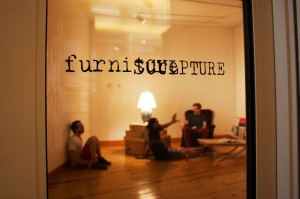By Christopher Squier
squierch@grinnell.edu
What is sculptifurniture? This is a question prompted by the recent Smith Gallery art show, courtesy of Andy Lange ’13. Lange’s show (dis)Functional Furniture was one of the briefer shows to grace the Smith Gallery, running from the beginning of the weekend through Wednesday morning, with a well-attended opening reception Monday afternoon (although not the briefest, as this semester has featured a notable number of labor-intensive exhibitions opening during their second scheduled week). The brevity of Lange’s show, however, is no indication of quality, as the show also proved to be one of the most rewarding to fill the space.
In fact, (dis)Functional Furniture masterfully transformed the Smith Gallery from its usual, oddly shaped box into a surprisingly well-designed interior, halfway between art installation and design showcase. Upon entering the Gallery, the quasi-sculptural design pieces were arranged to create the sparse impression of a living room interior, complete with well-worn armchair and side table reading material.
Of the three main pieces, the most salient was a beautifully sanded and artfully assembled table, slanted askew by a rounded base, similar to that of a rocking chair. The table slouches teeter totter-like in response to any object placed upon it, leaning left or right as one interacts with it.

“This was the realm on the border of usability and annoyance or un-usability, and [that’s] what I was really interested in,” Lange said.
This obstinate table, of course, was in perfect fitting with the show’s intentionally misspelled title—(dis)Functional Furniture aims to challenge our expectations of the functional as well as the role furniture and other belongings are intended to play in our lives.
“I started thinking about the idea of making a table that isn’t just passive and behaves the way you want it to, but interacts with you and makes you more cautious of the objects around you,” Lange said.
For the show, which was accomplished as part of a Mentored Advanced Project (MAP), Lange created pieces that respond in unexpected and often recalcitrant ways to their own use, subverting the traditional function of a piece of furniture.
“You might not know at first, if you’re not paying attention, that this table is going to rock,” Lange said. “I think that is going to make you much more engaged and contemplative of things around you.”
Nevertheless, his other two pieces trod a less definitive line between functional and subversive. It might be better for the artist to have presented these in more nebulous terms as simply existing in the intersection of sculpture and furniture, as the sculptifurniture window sticker advertised.
The swinging bookmark-bookshelves are debatable in some respects, presenting books in a way that also destroys their bindings, indiscernibly forcing open their stitching over time by means of a round metal rod. As a result, the piece serves a dual role in presenting good design in a way that can be seen as working against functionality.
For the piece supporting a bargain-value and price tag littered lamp, however, the case for dysfunction is not easily arguable. This third piece at first appears to be a collection of stacked crates, composed of particleboard and low-quality lumber.
Upon investigation, however, they reveal exactly the opposite quality as dysfunction, full of well-oiled drawers that slide in and out without the least resistance. While this piece questions our expectations in the same way as the others, it essentially works against the show’s title.
Nevertheless, the entire show transforms the Gallery into a cohesive and thought-provoking experience. Because of the mixture of functional with nonfunctional works, Lange creates an environment in which all expectations are called into question.
If the table must be perfectly balanced to work, it seems as if the armchair may be equally likely to collapse, investing even the ready-made objects in the exhibition with an unlikely uncertainty and fragility, and putting us, as viewers, in a place of cautious investigation.
The constant reminders throughout the room—and particularly in the text accompanying the work—of hidden errors and foiled expectations pique the viewer’s sense of caution and discovery.
In the wall text itself, the proliferation of misspellings and imperfectly formatted text blocks seems somewhat heavy-handed, but successfully reinforces the message of the show. In fact, the supplementary text echoes the show in a comfortably understandable reiteration of dysfunction.
It is noteworthy that when the room is chock full of visitors, the meaning of the pieces becomes more complicated. Multiplying the clearly delineated social relation between one viewer and a design or art object, a group of visitors questions the functionality of our everyday interactions.
The table topples to the side if one person leans closer in to listen to another, and tabletop belongings are sent sliding. If the room is crowded, one must navigate the maze of hanging books to move around the Gallery’s backside. Even our interactions separate from Lange’s intervening pieces come under fire. How can we expect to clap while holding a can of soda handed out during the reception? A host of quotidian dysfunctions become self-evident through the lens of Lange’s (dis)Functional Furniture.
In these moments in particular, Lange’s show succeeds in navigating the space between design and sculpture. Not only is his furniture a hybrid object, but the show itself raises questions beyond the function of mere objects. We are allowed the chance to examine our own lives for traces of dysfunction. We can therefore take something from (dis)Functional Furniture, as with all good art, to contribute to our lives outside of the gallery.

























































Christopher • Apr 13, 2013 at 2:13 am
Greeeeat photo